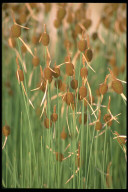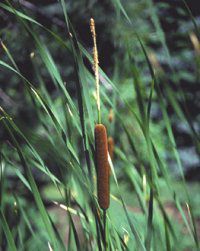 |
Common
Cattail
Typha
latifolia
This
is the cattail that commonly grows in the wild and
virtually everyone is familiar with. The leaves
grow up to 10 feet tall and 3/4 of an inch wide.
This cattail is too big to cultivate in the average
water garden because its size is overpowering and
it spreads rapidly. It would be good in a large
ponds as a vertical accent in the background. It
is easy to grow, it flowers in the summer and produces
'cattails' in late summer and fall, and is dormant
in winter.
Rhizomes can be dried and ground into flour. The
young shoots are edible raw. The green inflorescence
is edible after cooking, and the pollen may be eaten
raw.
|
 Hardy
from zone 3-9.
Hardy
from zone 3-9. |
| |
|
| Hardy
from zone 3 to 9. |
Variegated
Common Cattail
Typha
latifolia var. variegata
Variegated
cattail grows 3 or 4 feet high in containers, but
up to 7 feet with fertile soil and regular feeding.
It produces tall spikes and white and green striped,
broad leaves, which are terminated by green catkins,
3 inches in length. The catkins turn brown in the
summer. This type can be grown in 1 to 12 inches
of water.
|
Cattail
- Dwarf Graceful
Typha
laxmannii
With
very finely textured 3 foot grayish-green leaves,
and brown flowers, this species is more suitable
for decorative pool plantings. This plant is a much
more restrained Typha, growing little more than
3' high and producing slender, willowy leaves and
attractive dark brown pokers. It thrives in full
sun to partial shade, and will grow in mud or up
to 6" of water. Light brown catkins appear
in summer.
|
 Hardy
from zone
Hardy
from zone
3 to 9. |
| |
|
 Hardy
from zone 3 to 9.
Hardy
from zone 3 to 9. |
Cattail
- Micro-Mini
Typha
minima 'Europa'
12
to 18" tall with narrow needle like leaves, this is
a really delightful, dwarf species. This unique micro-miniature
cattail, has delicate reed-like leaves which are bluish-green
in color. Sporting masses of 1", round, extremely
attractive pokers, it is one of the most popular pond
plants available. Good for natural and lined
garden ponds, it grows in mud or up to 4" of water
and is non-invasive.
Top
of the pot should be 0-3" below the water surface.
|
| |
|
Narrow
Leaf Cattail
Typha
angustifolia
Narrow
dark blue-green leaves. Tolerates brackish water.
Perfect tall background for leafy foliage plants.
Flowers May to June.
Hardy from USDA Zone: 3 to 9.

|
 |
|
|
|


